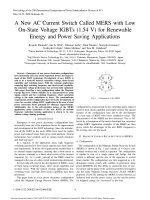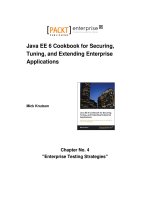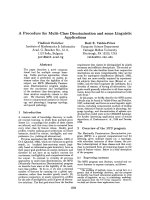Java EE 6 Cookbook for Securing, Tuning, and Extending Enterprise Applications pptx
Bạn đang xem bản rút gọn của tài liệu. Xem và tải ngay bản đầy đủ của tài liệu tại đây (4.27 MB, 210 trang )
www.it-ebooks.info
www.it-ebooks.info
Java EE 6
Pocket Guide
Arun Gupta
Beijing
•
Cambridge
•
Farnham
•
Köln
•
Sebastopol
•
Tokyo
www.it-ebooks.info
Java EE 6 Pocket Guide
by Arun Gupta
Copyright © 2012 Arun Gupta. All rights reserved.
Printed in the United States of America.
Published by O’Reilly Media, Inc., 1005 Gravenstein Highway North,
Sebastopol, CA 95472.
O’Reilly books may be purchased for educational, business, or sales promo-
tional use. Online editions are also available for most titles (ari
booksonline.com). For more information, contact our corporate/institutional
sales department: 800-998-9938 or
Editors: Mike Loukides and Meghan Blanchette
Copyeditor: Emily Quill
Production Editor: Kristen Borg
Proofreader: Kiel Van Horn
Indexer: Lucie Haskins
Cover Designer: Karen Montgomery
Interior Designer: David Futato
Illustrator: Rebecca Demarest
September 2012: First Edition.
Revision History for the First Edition:
2012-09-10 First release
See for release de-
tails.
Nutshell Handbook, the Nutshell Handbook logo, and the O’Reilly logo are
registered trademarks of O’Reilly Media, Inc. Java EE 6 Pocket Guide, the
image of a jellyfish (Favonia octonema), and related trade dress are trade-
marks of O’Reilly Media, Inc.
Many of the designations used by manufacturers and sellers to distinguish
their products are claimed as trademarks. Where those designations appear
in this book, and O’Reilly Media, Inc., was aware of a trademark claim, the
designations have been printed in caps or initial caps.
While every precaution has been taken in the preparation of this book, the
publisher and author assume no responsibility for errors or omissions, or for
damages resulting from the use of the information contained herein.
ISBN: 978-1-449-33668-4
[M]
1347298110
www.it-ebooks.info
To Menka,
my lovely wife and
best friend. Your
support and encour-
agement make our
lives fun and
meaningful.
To
Aditya and Mihir,
my two joyful boys,
for playing with me
and keeping me
charged.
www.it-ebooks.info
www.it-ebooks.info
Contents
Preface ix
Chapter 1: Java Platform, Enterprise Edition 1
Introduction 1
Deliverables 4
What’s New in Java EE 6 8
Chapter 2: Managed Beans 13
Define and Use a Managed Bean 14
Lifecycle Callback 15
Chapter 3: Servlets 17
Servlets 17
Servlet Filters 23
Event Listeners 25
Asynchronous Support 29
Web Fragments 31
Security 33
Resource Packaging 35
Error Mapping 37
Handling Multipart Requests 37
v
www.it-ebooks.info
Chapter 4: Java Persistence API 39
Entities 40
Persistence Unit, Persistence Context, and Entity Manager 43
Create, Read, Update, and Delete Entities 46
Validating the Entities 50
Transactions and Locking 52
Caching 54
Chapter 5: Enterprise JavaBeans 57
Stateful Session Beans 58
Stateless Session Beans 60
Singleton Session Beans 62
Message-Driven Beans 64
Portable Global JNDI Names 66
Transactions 67
Asynchronous 70
Timers 71
Embeddable API 76
EJB.Lite 77
Chapter 6: Contexts and Dependency Injection 79
Injection Points 80
Qualifier and Alternative 81
Producer and Disposer 84
Interceptors and Decorators 86
Scopes and Contexts 90
Stereotypes 92
Events 94
Portable Extensions 95
Chapter 7: JavaServer Faces 99
Facelets 100
vi | Table of Contents
www.it-ebooks.info
Resource Handling 104
Composite Components 105
Ajax 110
HTTP GET 113
Server and Client Extension Points 115
Navigation Rules 118
Chapter 8: SOAP-Based Web Services 121
Web Service Endpoints 123
Provider-Based Dynamic Endpoints 126
Endpoint-Based Endpoints 128
Web Service Client 129
Dispatch-Based Dynamic Client 132
Handlers 134
Chapter 9: RESTful Web Services 137
Simple RESTful Web Services 138
Binding HTTP Methods 140
Multiple Resource Representations 143
Binding Request to a Resource 144
Mapping Exceptions 147
Chapter 10: Java Message Service 149
Sending a Message 152
Quality of Service 155
Receiving a Message Synchronously 156
Receiving a Message Asynchronously 158
Temporary Destinations 159
Chapter 11: Bean Validation 161
Built-in Constraints 162
Defining a Custom Constraint 165
Table of Contents | vii
www.it-ebooks.info
Validation Groups 169
Integration with JPA
172
Integration with JSF 174
A: Getting Started with Java EE 6 Development and
Deployment 177
B: Further Reading 179
Index 183
viii | Table of Contents
www.it-ebooks.info
Preface
The Java EE 6 platform has taken ease-of-development in en-
terprise Java programming to new heights. This book is direc-
ted towards the audience who wants to get a quick overview
of the platform and to keep coming back to learn the basics.
This book provides an overview of the key specifications in the
Java EE 6 platform (one specification per chapter). The main
concepts from the different specifications are explained and
accompanied by code samples. No prior knowledge of earlier
versions of the platform is required. However, some basic un-
derstanding of Java is required to understand the code.
Conventions Used in This Book
The following typographical conventions are used in this book:
Italic
Indicates new terms, URLs, email addresses, filenames,
and file extensions.
Constant width
Used for program listings, as well as within paragraphs to
refer to program elements such as variable or function
names, databases, data types, environment variables,
statements, and keywords.
ix
www.it-ebooks.info
Constant width italic
Shows text that should be replaced with user-supplied
values or by values determined by context.
Using Code Examples
This book is here to help you get your job done. In general, you
may use the code in this book in your programs and docu-
mentation. You do not need to contact us for permission unless
you’re reproducing a significant portion of the code. For ex-
ample, writing a program that uses several chunks of code from
this book does not require permission. Selling or distributing
a CD-ROM of examples from O’Reilly books does require per-
mission. Answering a question by citing this book and quoting
example code does not require permission. Incorporating a
significant amount of example code from this book into your
product’s documentation does require permission.
We appreciate, but do not require, attribution. An attribution
usually includes the title, author, publisher, and ISBN. For ex-
ample: “Java EE 6 Pocket Guide by Arun Gupta (O’Reilly).
Copyright 2012 Arun Gupta, 978-1-449-33668-4.”
If you feel your use of code examples falls outside fair use
or the permission given above, feel free to contact us at
Safari® Books Online
Safari Books Online (www.safaribookson
line.com) is an on-demand digital library that
delivers expert content in both book and video
form from the world’s leading authors in tech-
nology and business.
Technology professionals, software developers, web designers,
and business and creative professionals use Safari Books
x | Preface
www.it-ebooks.info
Online as their primary resource for research, problem solving,
learning, and certification training.
Safari Books Online offers a range of product mixes and pricing
programs for organizations, government agencies, and indi-
viduals. Subscribers have access to thousands of books,
training videos, and prepublication manuscripts in one fully
searchable database from publishers like O’Reilly Media, Pren-
tice Hall Professional, Addison-Wesley Professional, Microsoft
Press, Sams, Que, Peachpit Press, Focal Press, Cisco Press,
John Wiley & Sons, Syngress, Morgan Kaufmann, IBM Red-
books, Packt, Adobe Press, FT Press, Apress, Manning, New
Riders, McGraw-Hill, Jones & Bartlett, Course Technology,
and dozens more. For more information about Safari Books
Online, please visit us online.
How to Contact Us
Please address comments and questions concerning this book
to the publisher:
O’Reilly Media, Inc.
1005 Gravenstein Highway North
Sebastopol, CA 95472
800-998-9938 (in the United States or Canada)
707-829-0515 (international or local)
707-829-0104 (fax)
We have a web page for this book, where we list errata, exam-
ples, and any additional information. You can access this page
at />To comment or ask technical questions about this book, send
email to
For more information about our books, courses, conferences,
and news, see our website at .
Find us on Facebook: />Follow us on Twitter: />Preface | xi
www.it-ebooks.info
Watch us on YouTube: />Acknowledgments
This book was not possible without support from a multitude
of people.
First and foremost, many thanks to O’Reilly for trusting in me
and providing an opportunity to write this book. Their team
provided excellent support throughout the editing, reviewing,
proofreading, and publishing process.
At O’Reilly, Michael Loukides helped me with bootstrapping
the book. Meghan Blanchette provided excellent editorial help
throughout all the stages, helping with interim reviews, pro-
viding feedback on styling, arranging technical reviews, and
connecting me with the rest of the team when required. Jessica
Hosman helped me in getting started and guided the authoring
process.
Emily Quill and Kristen Borg helped with copyediting and
making sure to provide the finishing touches. And thanks to
the rest of the O'Reilly team with whom I did not interact di-
rectly, but were helping in many other ways.
The detailed proofreading and technical review by Markus
Eisele (@myfear, ), John Yeary (@jyeary,
), and Bert Ertman (@Bert
Ertman, ) ensured that the rel-
evant content was covered accurately. Their vast experience
and knowledge showed in the depth of their comments.
I am grateful for the numerous discussions with developers
around the world that helped me understand the technology
better. Thanks to my colleagues at Oracle and the JSR specifi-
cation leads for explaining the intended use cases of different
technologies. And thanks to everybody else in my life, who
provided much-needed breaks from book writing.
xii | Preface
www.it-ebooks.info
CHAPTER 1
Java Platform,
Enterprise Edition
Introduction
The Java Platform, Enterprise Edition (Java EE) provides a
standards-based platform for developing web and enterprise
applications. These applications are typically designed as
multitier applications, with a frontend tier consisting of web
frameworks, a middle tier providing security and transactions,
and a backend tier providing connectivity to a database or a
legacy system. The Java EE platform defines APIs for different
components in each tier, and also provides some additional
services such as naming, injection, and resource management
that span across the platform. Each component is defined in a
separate specification that also describes the API, javadocs, and
expected behavior.
The Java Platform, Enterprise Edition 6 (Java EE 6) was re-
leased in December 2009 and provides a simple, easy-to-use,
and complete stack for building such applications. The previ-
ous version of the platform, Java EE 5, took the first step in
providing a simplified developer experience. The Java EE 6
platform further improves upon the developer productivity
features and also adds a lot more functionality.
1
www.it-ebooks.info
The three main goals of the platform are:
Ease of use
The Java EE 6 platform takes ease of use to new heights
by extensively using convention over configuration and
heavy use of annotations on a Plain Old Java Object
(POJO). Adding @Stateless, @Stateful, or @Singleton to
a POJO makes it an Enterprise JavaBean. Further, this
could be easily packaged in a WAR file instead of a special
packaging of JAR or EAR. Servlets are POJOs as well, an-
notated with @WebServlet. Deployment descriptors like
web.xml and faces-config.xml are optional in most cases;
the information typically specified in deployment descrip-
tors is now captured in annotations. There are default
rules of navigation from one page of JSF to another. Pub-
lishing a POJO as a RESTful web service is equivalent to
adding an @Path annotation on a POJO.
Making deployment descriptors optional, using conven-
tion over configuration, and relying heavily on annota-
tions makes the Java EE 6 platform easy to use and, above
all, less verbose.
Lightweight
There are 31 component specifications in the Java EE 6
platform, as listed in Appendix EE.6 of the platform spec-
ification. These components include Enterprise JavaBeans
(EJB), Servlets, JavaServer Faces (JSF), Java API for REST-
ful Web Services (JAX-RS), and many others. Building a
typical enterprise application may not require all the com-
ponents. Also, some of the technologies like Java API for
XML Registries (JAXR) or Java API for XML-based RPC
(JAX-RPC) were very relevant when introduced in the
platform. Now they have either been replaced by better
components, such as Java API for XML Web Services
(JAX-WS), or are no longer used.
The Java SE Expert Group defined a two-step process for
removing features from the platform. In this process,
known as pruning, a feature is marked as optional (re-
ferred to as proposed optional) in one release, and then a
2 | Chapter 1: Java Platform, Enterprise Edition
www.it-ebooks.info
subsequent release can decide to either remove the fea-
ture, retain it as a required component, or leave it in the
proposed removal state. The Java EE Expert Group used
that process and targeted some features for pruning. This
is analogous to trimming rose bushes in the beginning of
each year so that fresh blossoms can grow. Pruning un-
used features ensures that even with new feature addi-
tions, the platform will remain simple and lightweight.
The Java EE platform also introduces the notion of pro-
files. A profile represents a configuration of the platform
suited to a particular class of applications. A profile may
be a subset or superset of the technologies in the platform.
The Java EE 6 Web Profile is defined as a separate speci-
fication in the platform, and is defined as a subset of tech-
nologies contained in the platform and targeted toward
the developers of modern web applications. This breaks
away from the “one size fits all” approach of previous re-
leases. And although it’s a proper subset, it still offers a
reasonably complete stack composed of standard APIs,
and it’s capable out-of-the-box for addressing a wide va-
riety of web applications. The web profile allows devel-
opers to build web applications quickly and prevents the
proliferation of custom web stacks for easier maintaina-
bility. Additional profiles can be defined by following the
rules of the Java Community Process (JCP).
Together, pruning and web profiles make the Java EE 6
platform lightweight and simple to maintain.
Extensibility
The platform provides a rich set of functionality to create
enterpise applications. However, it’s a common practice
to include third-party frameworks to supplement or com-
plement functionality in the platform. These frameworks
require registration of a ServletListener, ServletFilter,
or similar component so that they are recognized by the
runtime. The Servlet specification defines a web frag-
ment mechanism by which these entry points to the frame-
work are defined in the framework library. The Servlet
Introduction | 3
www.it-ebooks.info
containers then register the framework, relieving the de-
veloper of the burden. This allows these frameworks to be
treated as first-class citizens of the platform.
In addition, the Contexts and Dependency Injection
(CDI) specification defines a portable extension mecha-
nism that allows you to extend the capabilities of the plat-
form in different ways, for example by providing certain
predefined scopes. A new scope can be easily defined and
included with any Java EE 6–compliant application server
using the portable extensions method.
Specifications like CDI, JavaServer Faces 2, Java API for REST-
ful Services, Java Persistence API 2, and Servlets 3 make the
Java EE 6 platform more powerful. This book will provide an
overview of the main technologies included in the platform,
and easy-to-understand code samples will be used throughout
to demonstrate improvements in Java EE 6.
Deliverables
The Java EE 6 platform was developed as Java Specification
Request 316 or JSR 316 ( fol-
lowing Java Community Process (JCP) 2.7. The JCP process
defines three key deliverables for any JSR:
Specification
A formal document that describes the proposed compo-
nent and its features.
Reference Implementation (RI)
Binary implementation of the proposed specification. The
RI helps to ensure that the proposed specifications can be
implemented in a binary form and provides constant feed-
back to the specification process.
Technology Compliance Kit (TCK)
A set of tests that verify that the RI is in compliance with
the specification. This allows multiple vendors to provide
compliant implementations.
4 | Chapter 1: Java Platform, Enterprise Edition
www.it-ebooks.info
Java EE 6 consists of the platform specification that defines
requirements across the platform. It also consists of the fol-
lowing component specifications:
Web Technologies
• JSR 45: Debugging Support for Other Languages
• JSR 52: Standard Tag Library for JavaServer Pages
(JSTL)1.2
• JSR 245: JavaServer Pages (JSP) 2.2 and Expression
Language (EL) 1.2
• JSR 314: JavaServer Faces (JSF) 2.0
• JSR 315: Servlet 3.0
Enterprise Technologies
• JSR 250: Common Annotations for the Java
Platform 1.1
• JSR 299: Contexts and Dependency Injection (CDI)
for the Java EE Platform 1.0
• JSR 303: Bean Validation 1.0
• JSR 316: Managed Beans 1.0
• JSR 317: Java Persistence API (JPA) 2.0
• JSR 318: Enterprise JavaBeans (EJB) 3.1
• JSR 318: Interceptors 1.1
• JSR 322: Java EE Connector Architecture 1.6
• JSR 330: Dependency Injection for Java 1.0
• JSR 907: Java Transaction API (JTA) 1.1
• JSR 914: Java Message Server (JMS) 1.1
• JSR 919: JavaMail 1.4
Web Service Technologies
• JSR 67: Java APIs for XML Messaging (JAXM) 1.3
• JSR 93: Java API for XML Registries (JAXR) 1.0
• JSR 101: Java API for XML-based RPC (JAX-
RPC) 1.1
• JSR 109: Implementing Enterprise Web Services 1.3
Deliverables | 5
www.it-ebooks.info
• JSR 173: Streaming API for XML (StAX) 1.0
• JSR 181: Web Services Metadata for the Java Plat-
form 2.0
• JSR 222: Java Architecture for XML Binding
(JAXB) 2.2
• JSR 224: Java API for XML Web Services (JAX-
WS) 2.2
• JSR 311: Java API for RESTful Web Services (JAX-
RS) 1.1
Management and Security Technologies
• JSR 77: J2EE Management API 1.1
• JSR 88: Java Platform EE Application Deployment
API 1.2
• JSR 115: Java Authorization Contract and Contain-
ers (JACC) 1.3
• JSR 196: Java Authentication Service Provider Inte-
face for Containers (JASPIC) 1.0
The different components work together to provide an inte-
grated stack, as shown in Figure 1-1.
Figure 1-1. Java EE 6 architecture
6 | Chapter 1: Java Platform, Enterprise Edition
www.it-ebooks.info
In Figure 1-1:
• JPA, JTA, and JMS provide the basic services such as da-
tabase access, transactions, and messaging.
• Managed Beans and EJB provide a simplified program-
ming model using POJOs to use the basic services.
• CDI, Interceptors, and Common Annotations provide
concepts that are applicable to a wide variety of compo-
nents, such as type-safe dependency injection, addressing
cross-cutting concerns using interceptors, and a common
set of annotations.
• CDI Extensions allow you to extend the platform beyond
its existing capabilities in a standard way.
• Web services using JAX-RS and JAX-WS, JSF, JSP, and EL
define the programming model for web applications. Web
Fragments allow automatic registration of third-party web
frameworks in a very natural way.
• Bean Validation provides a standard means to declare
constraints and validate them across different
technologies.
JAX-RPC (JSR 101), JAXR (JSR 93), EJB Entity Beans (part of
JSR 153), and Java EE Application Deployment (JSR 88) are
marked for pruning in this version of the platform.
The RI of Java EE 6 is built in the GlassFish Community. The
GlassFish Server Open Source Edition provides a full Java
EE 6–compliant, free, and open source application server. It is
also available in a Web Profile distribution and can be down-
loaded from . The application server is easy
to use (zip installer and NetBeans/Eclipse/IntelliJ integration),
lightweight (downloads starting at 30 MB, small disk/memory
footprint), and modular (OSGi-based, containers start on
demand). It also provides clustering with high availability and
centralized administration using CLI, web-based administra-
tion console, and REST management/monitoring APIs. The
Oracle GlassFish Server is Oracle’s commercially supported
GlassFish server distribution and can be downloaded from
Deliverables | 7
www.it-ebooks.info
As of this writing, there are 17
Java EE 6–compliant application servers. The complete list is
available at />overview/compatibility-jsp-136984.html.
The TCK is available to all Java EE licensees for testing their
respective implementations.
What’s New in Java EE 6
Some new specifications have been added to improve the func-
tionality and richness of the platform. Several existing compo-
nent specifications were revised to make them simple and easy
to use.
The main features of the key specifications are described.
Managed Beans
• POJO-based managed component.
• Provides common set of services such as lifecycle re-
source injection, callbacks, and interceptors.
Enterprise JavaBeans
• An EJB can be created with a single source file per
bean and annotated with @Stateless, @Stateful, or
@Singleton.
• EJBs can be packaged in a .war for local access using
@Local and ejb-jar for local and remote access.
• EJBs can be accessed using a portable global JNDI
name.
• A method of a session bean may be marked to be
invoked asynchronously. These methods allow the
client to retrieve the result value later, or use the fire-
and-forget pattern.
• Time-based events can be scheduled using cron-like
syntax by specifying @Schedule on bean methods.
8 | Chapter 1: Java Platform, Enterprise Edition
www.it-ebooks.info
• The Embeddable EJB API allows client code and its
corresponding enterprise beans to run within the
same JVM and the class loader.
Servlets
• Annotation-driven Servlet (@WebServlet), Filter (@Web
Filter), and Listener (@WebListener). The web.xml
descriptor becomes optional in most of the common
cases.
• Servlets, filters, and listeners can be programmati-
cally registered using ServletContext.
• Asynchronous servlets allow the control (or thread)
to return back to the container to perform other tasks
while waiting for the long-running process to
complete.
• Framework libraries can be integrated in a modular
way using web-fragment.xml.
• Servlet security can be specified using @ServletSecu
rity, @HttpConstraint, and @HttpMethodConstraint in
addition to <security-constraint>.
Java API for RESTful Web Services
• POJO-based and annotation-driven way of publish-
ing RESTful web services.
• Standard set of HTTP protocol methods such as
GET, POST, PUT, and DELETE are supported.
• Each resource can be represented in multiple for-
mats; custom types are supported as well.
• Client-side content negotiation supported using
HTTP Accept: header.
SOAP-Based Web Services
• Publish SOAP-based web services using a POJO and
annotations. Finer grained control over the messages
using Source, DataSource, and SOAPMessage.
• Client-side API to invoke a SOAP-based web service.
What’s New in Java EE 6 | 9
www.it-ebooks.info
• Well-defined extension points for pre/post process-
ing of request/response messages on client and
server.
• Standard Java-to-WSDL and WSDL-to-Java
mapping.
JavaServer Faces
• Facelets is defined as the preferred templating lan-
guage for the page. This allows composite compo-
nents to be easily defined, enabling true abstraction.
• Support for Ajax using JavaScript APIs and declara-
tive Ajax using f:ajax.
• Most of the elements in faces-config.xml have an al-
ternative annotation. Default navigation rules are de-
fined following convention-over-configuration.
• HTTP GET support and bookmarkable URLs.
• Integration with Bean Validation.
Java Persistence API
• An improved object/relational mapping to provide
more intuitive Java mapping. An expanded and
richer JPQL to support the improved mapping and
some new functionality.
• The Metamodel captures a metamodel of the persis-
tent state and relationships of the managed classes of
a persistence unit. This abstract persistence schema
is then used to author the type-safe queries using
Criteria API.
• Pessimistic locking is supported in addition to opti-
mistic locking by the addition of new locking modes.
• Standard configuration options using javax.persis
tence properties.
10 | Chapter 1: Java Platform, Enterprise Edition
www.it-ebooks.info
Interceptors
• Interpose on invocations and lifecycle events that
occur on an associated target class.
• Interceptors can be applied using annotations such
as @Interceptors or in a type-safe manner using a de-
ployment descriptor such as beans.xml.
Contexts and Dependency Injection
• Standards-based type-safe dependency injection.
• Provides strong typing by specifying all dependencies
using Java type system. Provides loose coupling with
Events, Interceptors, and Decorators.
• Provides an integration with Expression Language.
• Defines an extensible scope and context manage-
ment mechanism.
• Bridges transactional tier (EJB) and presentation tier
(JSF) in the platform.
Bean Validation
• Class-level constraint declaration and validation fa-
cility for POJOs.
• Provides a built-in set of constraint definitions such
as @NotNull, @Min, @Max, and @Size.
• Custom constraints can be declared using META-
INF/validation.xml in addition to annotations.
What’s New in Java EE 6 | 11
www.it-ebooks.info









